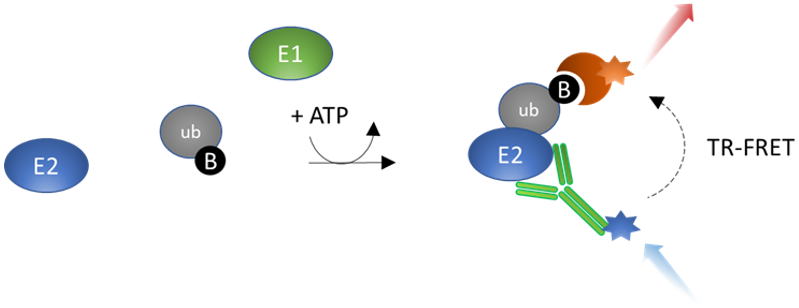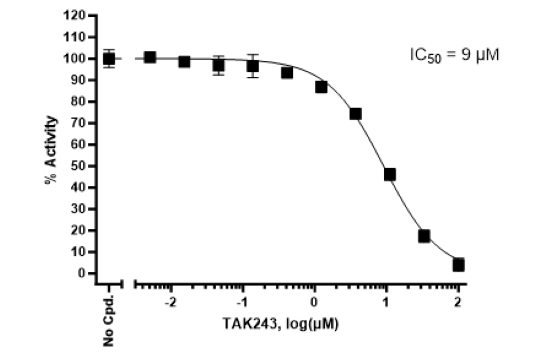Ubi-Trans™ UBE1-UbcH5b TR-FRET Assay Kit
The Ubi-Trans™ UBE1-UbcH5b TR-FRET Assay Kit is a homogeneous, sensitive TR-FRET (Time-Resolved Fluorescence Resonance Energy Transfer) assay designed to measure UBE1 (ubiquitin- activating enzyme 1)-dependent transfer of Ub (ubiquitin) to UbcH5b (Ubiquitin-conjugating enzyme E2 D2) E2 enzyme. It utilizes a Terbium (Tb)-labeled donor and a dye-labeled streptavidin acceptor to complete the TR-FRET pairing. The kit comes in a convenient 384-well format and contains enough purified UbcH5b, purified UBE1, Biotin-Ubiquitin, anti-His Tb (terbium)-labeled donor, dye-labeled streptavidin acceptor, and assay buffer for 400 reactions.

Figure 1: Ubi-Trans™ UBE1-UbcH5b TR-FRET Assay Kit schematic.
In the presence of ATP, UBE1 transfers biotin-conjugated ubiquitin to the substrate UbcH5b (E2). The Tb-labeled anti-His antibody binds to the His-tagged E2 enzyme, while the dye-labeled streptavidin acceptor binds to Biotin-Ubiquitin. The complex forms when ubiquitin is transferred to the E2 enzyme by E1. In the absence of ubiquitination, the complex does not form and energy transfer does not occur. When E2 is ubiquitinated the complex is formed, TR-FRET pairing is complete, and an increase in acceptor emission is observed. Thus, TR-FRET signal is proportional to UBE1 activity.
Need us to run inhibitor screens or profile your compounds against UBE1? Check out our Ubiquitination Screening Services.
- Fluorescent microplate reader capable of measuring Time Resolved Fluorescence Resonance Energy Transfer (TR-FRET)
- Adjustable micropipettor and sterile tips
- Rotating or rocker platform
| Catalog # | Name | Amount | Storage |
| 80301 | UBE1 (UBA1), FLAG-Tag* | 4.8 µg | -80°C |
| 80314 | UbcH5b, His-Tag (Human)* | 5 µg | -80°C |
| Biotin-Ubiquitin | 80 µl | -80°C | |
| 4 mM ATP | 1 ml | -80°C | |
| 78856 | U2 Assay Buffer | 2 x 10 ml | -80°C |
| 30017 | Anti-His Tb-Labeled Donor | 10 µl | -20°C |
| Dye-Labeled Acceptor | 10 µl | -20°C | |
| 79969 | White, nonbinding, low volume microtiter plate | Room Temp |
* The initial concentration of enzyme is lot-specific and will be indicated on the tube containing the protein.
Ubiquitination is a multistep process that involves E1 (ubiquitin-activating enzymes), E2 (ubiquitin-conjugating enzymes) and E3 (ubiquitin ligase) enzymes. In the first step, an E1-ubiquitin thioester bond is formed between the C-terminal glycine carboxyl group of ubiquitin and the cysteine in the active site of the E1 enzyme in an ATP-dependent reaction. Next, the E1 enzyme transfers the activated ubiquitin to the cysteine residue of the E2 enzyme to form an E2-ubiquitin thioester-linked intermediate by transesterification. Finally the E2 enzyme transfers ubiquitin to the substrate protein with the help of an E3 ligase. UBE1 (ubiquitin-like modifier activating enzyme 1, or UBA1) is an E1 enzyme that activates ubiquitin. It plays a role in UPS (ubiquin-proteosome system) and selective ub-dependent autophagy. UBE1 can transfer ubiquitin to UbcH5b (also known as Ubiquitin-conjugating Enzyme E2 D2, UBE2D2). UbcH5b is overexpressed in certain cancer types. It functions in the ubiquitination of tumor-suppressor proteins p53 and p62, promoting their degradation. UbcH5b-p62 complex confers therapeutic resistance in triple negative breast cancer cells. UbcH5b is also involved in endocytosis-mediated degradation of MHC (major histocompatibility complex) class I molecules, and overexpression has been found in inflammatory bowel disease. Inhibitors of ubiquitination of UbcH5b by UBE1 may prove beneficial in the treatment of cancer and auto-immune diseases.
Saville M.K., et al., 2004 J. Biol. Chem.279(40): 42169-81.
Kim J.H., et al., 2015 BMB Rep. 48(1): 25-29.
Lambert-Smith I., et al., 2020 The International Journal of Biochemistry & Cell Biology 123:105746.


